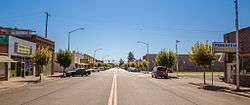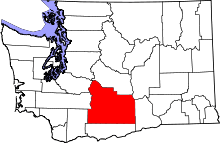Wapato, Washington
| Wapato, Washington | |
|---|---|
| City | |
|
Wapato Avenue | |
 Location of Wapato, Washington | |
 Wapato, Washington Location in the United States | |
| Coordinates: 46°26′44″N 120°25′19″W / 46.44556°N 120.42194°WCoordinates: 46°26′44″N 120°25′19″W / 46.44556°N 120.42194°W | |
| Country | United States |
| State | Washington |
| County | Yakima |
| Area[1] | |
| • Total | 1.17 sq mi (3.03 km2) |
| • Land | 1.17 sq mi (3.03 km2) |
| • Water | 0 sq mi (0 km2) |
| Elevation | 856 ft (261 m) |
| Population (2010)[2] | |
| • Total | 4,997 |
| • Estimate (2015)[3] | 5,068 |
| • Density | 4,270.9/sq mi (1,649.0/km2) |
| Time zone | Pacific (PST) (UTC-8) |
| • Summer (DST) | PDT (UTC-7) |
| ZIP code | 98951 |
| Area code | 509 |
| FIPS code | 53-76125 |
| GNIS feature ID | 1512774[4] |
| Website | City of Wapato |
Wapato is a city in Yakima County, Washington, United States. The population was 4,997 at the 2010 census.
History
The town was originally founded in 1885 by Indian Postmaster Alexander McCredy as a railroad stop on the Northern Pacific Railroad as Simcoe, Washington. The Dawes Severalty Act of 1887 made it legal for the Yakama Indian Nation to sell their lands, and began to draw settlers into the area. With the construction of the Irwin Canal in 1896, agriculture became the big business in town. In the early 1900s, McCredy and George Rankin established the Wapato Development Company and laid out the town site. They established the town's first bank and began selling lots. In response to persistent confusion with nearby Fort Simcoe, the town changed its name to Wapato in 1903. The 1906 Jones Act further encouraged Anglos to purchase land from the Yakamas. Wapato was officially incorporated on September 16, 1908 with a population of around 300 people.
As early as 1905, many Japanese people also began to migrate to the city, mainly from Hawaii. From 1916 to 1918, "Japanese Town" developed along present-day West 2nd Street. With more than 1000 Japanese then living in the Yakima Valley, the community soon became a center of Washington's Japanese population, second only to Seattle. The Yakima Buddhist Bussei Kaikan (1936–1941), on West 2nd Street, was an architecturally noteworthy building built by members of the congregation.[5] Unfortunately it was not to last, as Roosevelt's Executive Order 9066 forced the Japanese to evacuate from Wapato in 1942, many residents headed for internment camps.
During World War II, much of the labor in the orchards and fields around Wapato came from either Germans held in a POW camp between Wapato and Toppenish, or from Japanese still being held in internment camps. At the end of the war, a labor shortage created a void readily filled by Hispanic migrant workers, and the Bracero Program (a guest-worker program agreed to by the US and Mexico during World War II). These events significantly changed Wapato's cultural history.
Through the 1970s and into 1990, Wapato produced some of the largest volume potato and apple crops, as tonnage per acre.
Today, Wapato boasts one of the most Hispanic populations in Washington State (76% in the 2000 census). In recent times both Anglo and Hispanic residents have described Wapato as a "Mexican Town".[6]
In 2012, Wapato allowed strip clubs into the city, in the words of one resident, "to put Wapato on the map."[7]
Geography
Wapato is located at 46°26′44″N 120°25′19″W / 46.44556°N 120.42194°W (46.445521, -120.421822).[8] According to the United States Census Bureau, the city has a total area of 1.17 square miles (3.03 km2), all land.[1] The community is within the external boundaries of the Yakama Indian Reservation. [9][10]
Climate
According to the Köppen Climate Classification system, Wapato has a cold semi-arid climate, abbreviated "BSk" on climate maps.
| Climate data for Wapato | |||||||||||||
|---|---|---|---|---|---|---|---|---|---|---|---|---|---|
| Month | Jan | Feb | Mar | Apr | May | Jun | Jul | Aug | Sep | Oct | Nov | Dec | Year |
| Record high °F (°C) | 68 (20) |
72 (22) |
86 (30) |
94 (34) |
102 (39) |
104 (40) |
110 (43) |
106 (41) |
101 (38) |
89 (32) |
75 (24) |
68 (20) |
110 (43) |
| Average high °F (°C) | 38.6 (3.7) |
47.4 (8.6) |
57.5 (14.2) |
66 (19) |
74.5 (23.6) |
81.2 (27.3) |
89.2 (31.8) |
87.8 (31) |
79.5 (26.4) |
66.5 (19.2) |
49.8 (9.9) |
39.5 (4.2) |
64.8 (18.2) |
| Average low °F (°C) | 22.8 (−5.1) |
27.4 (−2.6) |
33 (1) |
39.3 (4.1) |
46.9 (8.3) |
53.6 (12) |
59.4 (15.2) |
57.3 (14.1) |
48.9 (9.4) |
38.4 (3.6) |
29.9 (−1.2) |
24.7 (−4.1) |
40.1 (4.5) |
| Record low °F (°C) | −22 (−30) |
−21 (−29) |
6 (−14) |
18 (−8) |
26 (−3) |
33 (1) |
36 (2) |
35 (2) |
23 (−5) |
12 (−11) |
−9 (−23) |
−27 (−33) |
−27 (−33) |
| Average precipitation inches (mm) | 1.02 (25.9) |
0.68 (17.3) |
0.55 (14) |
0.47 (11.9) |
0.53 (13.5) |
0.57 (14.5) |
0.23 (5.8) |
0.28 (7.1) |
0.34 (8.6) |
0.54 (13.7) |
0.98 (24.9) |
1.15 (29.2) |
7.35 (186.7) |
| Average snowfall inches (cm) | 5.8 (14.7) |
2.2 (5.6) |
0.7 (1.8) |
0 (0) |
0 (0) |
0 (0) |
0 (0) |
0 (0) |
0 (0) |
0 (0) |
1.9 (4.8) |
5.4 (13.7) |
15.9 (40.4) |
| Average precipitation days | 8 | 6 | 5 | 4 | 4 | 4 | 2 | 2 | 3 | 4 | 7 | 8 | 57 |
| Source: [11] | |||||||||||||
Demographics
| Historical population | |||
|---|---|---|---|
| Census | Pop. | %± | |
| 1910 | 400 | — | |
| 1920 | 1,128 | 182.0% | |
| 1930 | 1,222 | 8.3% | |
| 1940 | 1,483 | 21.4% | |
| 1950 | 3,185 | 114.8% | |
| 1960 | 3,137 | −1.5% | |
| 1970 | 2,841 | −9.4% | |
| 1980 | 3,307 | 16.4% | |
| 1990 | 3,795 | 14.8% | |
| 2000 | 4,582 | 20.7% | |
| 2010 | 4,997 | 9.1% | |
| Est. 2015 | 5,068 | [12] | 1.4% |
| U.S. Decennial Census[13] 2015 Estimate[3] | |||
For several decades Wapato attracted Filipino Americans, Hispanic Americans, Japanese Americans, and Native Americans. At one time White Americans were nearly half of the city's population. As time passed older whites died and entered nursing homes in larger cities, while younger whites moved to attend school and did not return to the community. Hispanic immigrants continued to come to the town due to the availability of jobs in agriculture and the small town lifestyle.[10]
2010 census
As of the census[2] of 2010, there were 4,997 people, 1,240 households, and 1,045 families residing in the city. The population density was 4,270.9 inhabitants per square mile (1,649.0/km2). There were 1,293 housing units at an average density of 1,105.1 per square mile (426.7/km2). The racial makeup of the city was 17.2% White, 0.3% African American, 6.6% Native American, 1.3% Asian, 0.1% Pacific Islander, 70.6% from other races, and 3.9% from two or more races. Hispanic or Latino of any race were 84.2% of the population.
There were 1,240 households of which 64.7% had children under the age of 18 living with them, 51.1% were married couples living together, 22.7% had a female householder with no husband present, 10.4% had a male householder with no wife present, and 15.7% were non-families. 11.7% of all households were made up of individuals and 5.3% had someone living alone who was 65 years of age or older. The average household size was 3.88 and the average family size was 4.12.
The median age in the city was 24.9 years. 37% of residents were under the age of 18; 13.1% were between the ages of 18 and 24; 27.2% were from 25 to 44; 16.1% were from 45 to 64; and 6.7% were 65 years of age or older. The gender makeup of the city was 50.5% male and 49.5% female.
2000 census
As of the census of 2000, there were 4,582 people, 1,198 households, and 971 families residing in the city. The population density was 4,725.2 people per square mile (1,823.8/km²). There were 1,267 housing units at an average density of 1,306.6 per square mile (504.3/km²). The racial makeup of the city was 25.51% White, 0.50% African American, 9.34% Native American, 1.53% Asian, 57.57% from other races, and 5.54% from two or more races. Hispanic or Latino of any race were 76.21% of the population.
There were 1,198 households out of which 53.3% had children under the age of 18 living with them, 53.6% were married couples living together, 19.2% had a female householder with no husband present, and 18.9% were non-families. 15.5% of all households were made up of individuals and 7.7% had someone living alone who was 65 years of age or older. The average household size was 3.73 and the average family size was 4.10.
In the city the age distribution of the population shows 38.2% under the age of 18, 12.1% from 18 to 24, 26.5% from 25 to 44, 14.7% from 45 to 64, and 8.4% who were 65 years of age or older. The median age was 25 years. For every 100 females there were 104.7 males. For every 100 females age 18 and over, there were 102.2 males.
The median income for a household in the city was $25,804, and the median income for a family was $26,378. Males had a median income of $18,333 versus $19,375 for females. The per capita income for the city was $9,451. About 32.2% of families and 34.3% of the population were below the poverty line, including 41.6% of those under age 18 and 12.7% of those age 65 or over.
Education
Public education is provided by the Wapato School District, also known as Wapato Public Schools, which operates six schools.
References
- 1 2 "US Gazetteer files 2010". United States Census Bureau. Retrieved 2012-12-19.
- 1 2 "American FactFinder". United States Census Bureau. Retrieved 2012-12-19.
- 1 2 "Population Estimates". United States Census Bureau. Retrieved June 29, 2016.
- ↑ "US Board on Geographic Names". United States Geological Survey. 2007-10-25. Retrieved 2008-01-31.
- ↑ Heather M. MacIntosh, November 03, 1998 (1998-11-03). "the Free Online Encyclopedia of Washington State History". HistoryLink.org. Retrieved 2014-01-30.
- ↑ Guzman, Gonzalo (2006-09-16). "the Free Online Encyclopedia of Washington State History". HistoryLink.org. Retrieved 2014-01-30.
- ↑ "Will Wapato have the first strip clubs in the valley? | Top Video | KIMA CBS 29 - News, Weather and Sports - Yakima, WA". Kimatv.com. Retrieved 2014-01-30.
- ↑ "US Gazetteer files: 2010, 2000, and 1990". United States Census Bureau. 2011-02-12. Retrieved 2011-04-23.
- ↑ Yakama Nation. . Retrieved on August 29, 2016.
- 1 2 Shapiro, Nina. "Welcome to Mi Pueblito, Washington." Houston Press. Thursday July 15, 2010. 2. Retrieved on July 16, 2010.
- ↑ "WAPATO, WASHINGTON (458959)". Western Regional Climate Center. Retrieved November 18, 2015.
- ↑ "Annual Estimates of the Resident Population for Incorporated Places: April 1, 2010 to July 1, 2015". Retrieved July 2, 2016.
- ↑ United States Census Bureau. "Census of Population and Housing". Retrieved July 21, 2014.
External links
| Wikimedia Commons has media related to Wapato, Washington. |

